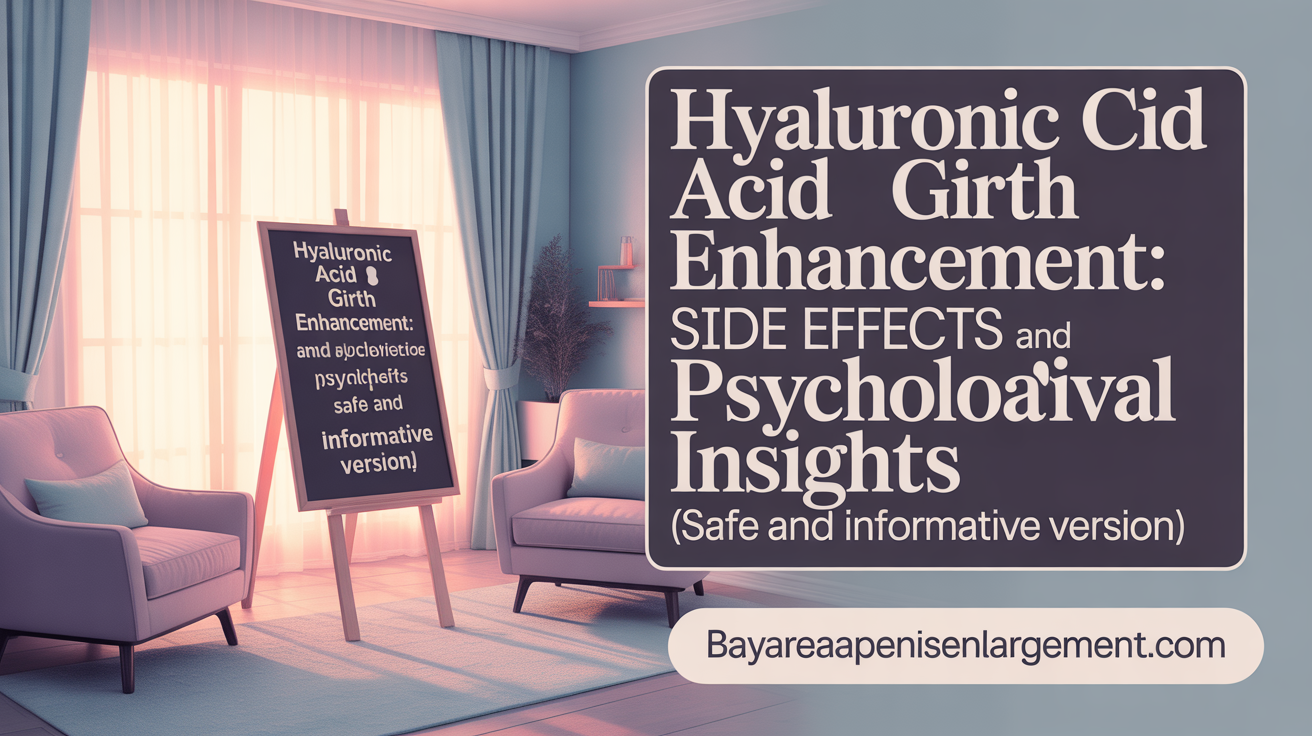Understanding the Psychological Aspects of Penis Lengthening
Penis lengthening procedures have increasingly attracted attention not only for their physical changes but also for their significant psychological and emotional effects. This article aims to delve into the psychological benefits men experience from these procedures, exploring motivations, mental health outcomes, body image improvements, and the complexities surrounding the decision to pursue penile enhancement. By integrating research findings and clinical insights, we present a comprehensive overview of the mental and emotional considerations related to penis lengthening, helping readers grasp the nuanced impacts beyond the physical results.
Psychological Motivations Behind Seeking Penis Enlargement

What are the psychological motivations for seeking penile enhancement?
Men pursue penile enlargement procedures mainly due to psychological reasons rooted in their self-esteem and body image. Many men perceive their penis as smaller than they believe it should be, the size they expect, or what they feel is necessary for sexual satisfaction and social masculinity.
A significant factor driving these pursuits is feelings of insecurity and dissatisfaction with their penile appearance. Men who feel that their size does not meet societal standards or personal expectations may experience embarrassment, shame, or anxiety that impacts their mental well-being.
Societal perceptions of masculinity and size heavily influence these motivations. Cultural norms and media portrayals often associate masculinity with larger penis size, fueling the belief that size equates to strength and sexual competence.
Some men experience symptoms of penile dysmorphic disorder (PDD) or body dysmorphic disorder (BDD), conditions that involve an obsessive concern with body image and perceived defects. Studies have shown that roughly 11% of men seeking enhancement reported BDD symptoms before procedures, a number that significantly drops after treatment.
The desire to improve sexual function and emotional well-being also motivates some men. Enhancements are believed to lead to better sexual satisfaction, increased confidence during intimacy, and improved partner stimulation.
Overall, these motivations stem from complex emotional and psychological factors, often intertwined with cultural ideals and personal insecurities. Many men seek enhancement not merely for physical change but as a way to reclaim confidence, assert masculinity, and foster healthier social and sexual relationships.
Benefits of Penis Lengthening on Self-Confidence and Sexual Satisfaction

How does penis lengthening improve self-confidence?
Many men seeking penis lengthening procedures report a boost in self-esteem and body image after the surgery. Feeling more secure about their physical appearance allows them to engage more confidently in social and intimate interactions. The psychological uplift is often linked to the perception of a larger or more proportionate penis, which many men believe aligns better with societal ideals of masculinity. As a result, men frequently find it easier to pursue new relationships or improve existing ones, leading to an overall sense of happiness and well-being.
What are the improvements in sexual satisfaction and pleasure?
Enhanced girth and perceived size can significantly influence sexual pleasure—for both men and their partners. Increased size can result in better stimulation, which heightens physical intimacy and mutual enjoyment. Men often feel more confident during intercourse, which can improve performance and satisfaction. Additionally, some studies suggest that penile enhancement supports better erectile function and the quality of erections, further contributing to sexual confidence and enjoyment.
How does penile enhancement affect relationships?
Psychological benefits extend beyond individual self-esteem. With increased confidence, men tend to be more assertive and open during sexual encounters. Partners often report higher levels of satisfaction, creating a positive cycle of intimacy. Physical improvements may facilitate better connection and communication within relationships, strengthening bonds and intimacy.
What is the impact on perceived penis size satisfaction?
Despite varying baseline sizes, many men perceive their penis as smaller than they would like, and this dissatisfaction can impact mental health. Post-procedure, feelings of size discrepancy are often reduced, leading to a more positive body image. These perceived improvements can translate into greater contentment and reduced anxiety regarding size, which is associated with healthier psychosocial outcomes.
How does body image and mental well-being benefit?
Men who undergo penile enhancement often experience a notable mental health boost. The surgery can help mitigate feelings of shame or inadequacy linked to penis size. Such psychological benefits can also improve general confidence and decrease symptoms of body dysmorphic disorder (BDD), which affects a minority of men seeking augmentation. When expectations are managed well, these procedures can support a more positive self-perception and contribute to overall emotional resilience.
| Benefit | Description | Additional Notes |
|---|---|---|
| Increased self-confidence | Boost in personal security about penis size | Supports social and romantic confidence |
| Improved sexual satisfaction | Enhanced pleasure and sexual performance | Leads to better intimacy with partners |
| Relationship effects | Better partner satisfaction and intimacy | Strengthens emotional bonds |
| Perceived size satisfaction | Reduced discrepancy between actual and ideal size | Fosters body image positivity |
| Mental well-being | Lowered anxiety and body dissatisfaction | Contributes to psychological health |
What are the psychological benefits of penis lengthening procedures?
Penis lengthening procedures can lead to psychological benefits such as increased self-confidence, improved body image, and enhanced sexual satisfaction for some men. Many report feeling more assured and satisfied with their appearance after experiencing an increase in perceived penis size. For individuals with body dysmorphic disorder (BDD), such procedures may reduce distress and help them meet psychological criteria for normalcy, contributing to better mental health. However, outcomes are variable, and not all men experience significant psychological improvements, highlighting the importance of realistic expectations. Overall, while some men may experience notable mental health benefits, these benefits are influenced by individual beliefs, societal pressures, and the actual results of the procedure.
The Influence of Penile Enhancement on Body Image and Mental Health

How can penile enhancement impact body image and mental health?
Men seeking penile girth augmentation often do so with the hope of improving how they perceive their bodies and, by extension, their overall mental health. Many report that the procedure results in a noticeable increase in their self-confidence and a more positive body image. This boost is especially significant for those who previously felt their penis was too small, which affected their feelings of masculinity or sexual adequacy.
The research indicates that almost half of the men experienced gains in self-esteem and sexual enjoyment after undergoing nonsurgical enhancement. They often find themselves more secure in intimate settings and more willing to engage socially, reflecting improved mental well-being linked to body image.
However, despite these physical and emotional enhancements, some men still view their penis as smaller than they would like, which keeps dissatisfaction lingering. This ongoing perception suggests that while size increase can contribute to better body image, it does not automatically resolve all self-esteem issues. For some, psychological factors like body dysmorphic disorder (BDD) initially contribute to concern about penis size. Thankfully, the prevalence of BDD decreases substantially after the procedure, with affected men no longer meeting clinical criteria for BDD by six months post-treatment.
Nonetheless, studies highlight that broad improvements in mental health, such as reductions in anxiety or depression related to body image, are not guaranteed. The psychological impact of penile enhancement can be complex, heavily influenced by societal, cultural, and personal beliefs.
In essence, while penile enhancement can positively modify perceptions related to size and boost confidence in specific areas like sexual performance and body image, it is not a universal solution for all mental health concerns. The psychological benefits tend to be more localized, improving confidence and satisfaction with appearance rather than transforming overall mental well-being.
Managing Expectations: Mental and Emotional Considerations

What are the mental and emotional considerations associated with penis enlargement procedures?
Men considering penile girth enhancements often have complex psychological motivations. While some experience boosts in confidence and sexual satisfaction afterward, these outcomes are not guaranteed for everyone.
A significant aspect of undergoing such procedures is managing realistic expectations. Many men perceive their penis size as smaller than their ideal, even after procedures that statistically increase girth by about 3.29 cm. This discrepancy can lead to ongoing dissatisfaction if expectations are not aligned with probable results.
Psychological issues like body dysmorphic disorder (BDD) and small penis anxiety (SPA) are common among men seeking enhancement. Studies estimate that before surgery, about 11% of men self-reported BDD, and 7% had clinical BDD. Remarkably, these rates dropped to 0% at six months post-procedure, indicating possible psychological improvement following their treatment.
However, the decision to undergo penile enhancement is often influenced by societal norms and cultural perceptions that equate masculinity with penis size. These societal pressures can cause men to pursue surgery out of insecurity rather than medical necessity.
The psychological risks are notable. Men might experience dissatisfaction if the outcomes do not meet their expectations or if underlying issues like BDD persist. In some cases, feelings of insecurity, shame, or anxiety can continue, or even worsen.
Addressing these concerns involves psychological support, including counseling and therapy, to explore motivations and manage expectations. Preoperative mental health assessments are recommended to identify those who might benefit from psychological interventions rather than surgery.
Ultimately, understanding the influence of societal standards of masculinity and personal beliefs about body image is vital. An emotionally healthy approach involves recognizing that improved self-esteem and confidence are often linked to realistic expectations, psychological support, and a thorough understanding of what surgery can and cannot achieve.
| Aspect | Consideration | Impact/Details |
|---|---|---|
| Mental health | Manage realistic expectations | Ensures satisfaction; prevents disappointment |
| Psychological risks | Address body dysmorphic disorder | Reduces long-term dissatisfaction; promotes emotional well-being |
| Societal influence | Be aware of cultural pressures | May unfairly influence decision-making |
| Emotional well-being | Pre- and post-surgical support | Supports adjustment and coping strategies |
| Overall considerations | Informed decision-making | Leads to healthier mental and emotional outcomes |
Considering these factors, men are encouraged to seek psychological counseling, especially if underlying insecurities or body image concerns are prominent. A comprehensive approach that includes mental health support can help ensure that decisions about penile enhancement are made with clarity and emotional readiness.
Psychological Risks and Potential Disadvantages of Penis Enlargement
What are the potential disadvantages and psychological risks associated with penis enlargement?
Penis enlargement procedures, whether surgical or non-invasive, carry various risks that can affect both physical health and mental well-being. Physically, these procedures can lead to complications including tissue damage, scarring, nerve injury, or even impaired erectile function. In some cases, complications may require additional interventions or ongoing treatment, increasing the risk of infection and adverse reactions.
From a psychological point of view, the outcomes are not always as expected. Men may experience heightened anxiety, disappointment, or dissatisfaction if the results fall short of their desired size or appearance. This can negatively impact self-esteem, especially if the perceived improvements do not alleviate underlying body image issues.
There’s also a risk of developing distorted perceptions of one’s anatomy. Men overly fixated on size may develop or exacerbate body dysmorphic disorder, a condition where preoccupation with perceived flaws interferes with daily life. By focusing excessively on size, some men lose sight of overall health and satisfaction.
It's crucial to recognize that pursuing penile enlargement without thorough understanding can lead to psychological distress. Potential risks include increased dissatisfaction with body image, ongoing anxiety, and even worsening mental health if expectations are not met.
Before deciding on an intervention, men should carefully consider these physical and emotional factors. Consulting qualified healthcare professionals and setting realistic expectations are essential steps in making an informed choice about penile enhancement options.
Permanent Options for Penis Enlargement: Psychological Impact and Realities
Overview of surgical methods for permanent penile enlargement
Men seeking a permanent increase in penis size have several surgical options available. These include the implantation of medical-grade silicone devices like the Penuma implant, which can significantly enhance girth and some cases length. Fat transfer procedures, where a man's own fat is injected into the penis, are also used to increase girth. Additionally, ligament release surgery can make the penis appear longer by releasing the suspensory ligament, although this approach often provides only modest gains.
While these techniques can offer lasting results, they are not without downsides. Surgical procedures carry inherent risks, including infection, scarring, loss of sensation, and, in some cases, erectile dysfunction. Moreover, the effectiveness varies based on the method used and the individual’s anatomy.
Expected physical outcomes and associated risks
Traditional surgical options typically deliver measurable results. For example, fat injections and tissue grafts can increase girth by about 2 to 5 centimeters, while implants can provide even more substantial and permanent size enhancements.
However, potential risks include complications like swelling, deformities, or loss of function. Some procedures, particularly those involving permanent fillers such as silicone or paraffin injections, pose significant safety issues and are strongly discouraged due to possible adverse effects like embolism or granuloma formation.
It’s crucial for men to have realistic expectations and discuss potential outcomes thoroughly with qualified healthcare professionals before undergoing any procedure.
Psychological benefits of permanent enlargement options
Pursuing permanent penile enlargement can lead to notable psychological benefits. Many men experience improvements in self-esteem and self-confidence, feeling more secure in their bodies and more assertive in personal and social interactions.
Enhanced size often correlates with greater sexual confidence, which can translate into better sexual performance and satisfaction for both partners. Additionally, overcoming size-related insecurities may help alleviate conditions like penile dysmorphic disorder, leading to mental well-being and improved quality of life.
These benefits are most pronounced when men have realistic expectations and seek procedures for the right reasons—primarily addressing genuine insecurities rather than superficial desires.
Importance of balanced expectations
It is vital to balance the desire for increased size with an understanding of what surgical procedures can realistically achieve. While some men experience significant improvements, others may find the results modest or encounter complications.
Surgeons emphasize managing expectations through preoperative counseling, advanced simulation techniques like 3D modeling, and transparent discussions about the possible outcomes and risks. This approach helps prevent dissatisfaction and supports mental preparedness.
Differences between surgical and nonsurgical outcomes
Nonsurgical methods such as vacuum pumps, traction devices, and temporary fillers offer short-term or cosmetic improvements, often with minimal risks. However, they typically do not produce permanent changes in size.
In contrast, surgical options aim for longer-lasting results. Despite this, the outcomes vary, and patients must be aware of the potential for complications or less-than-expected gains.
Ultimately, choosing between surgical and nonsurgical approaches depends on individual goals, health status, and tolerance for risks. Consultation with qualified urologists is essential to determine the most suitable option.
| Method | Expected Girth Increase | Duration of Effect | Risks & Notes |
|---|---|---|---|
| Penile Implants | Significant | Permanent | Infection, scarring, ED risk |
| Fat Transfer | 2-5 cm | Permanent, but possible fat resorption | Deformity, uneven results |
| Ligament Release | Modest, 1-2 cm | Permanent | Erectile dysfunction, cosmetic concerns |
| Injectable fillers | 2-3.8 cm | 6-18 months | Swelling, nodules, rare embolism |
Choosing permanent enlargement procedures should involve thorough evaluation and realistic expectation management.
Nonsurgical Techniques and Their Psychological Outcomes
What types of nonsurgical penile enhancement methods are available?
Nonsurgical penile enhancement options range from minimally invasive injections to non-invasive devices. Common methods include the use of dermal fillers such as hyaluronic acid and poly L-lactic acid, fat injections, vacuum pumps, and extenders. These approaches aim to increase girth or temporarily engorge the penis, providing a perceived larger size.
What size changes do these methods typically achieve, and how safe are they?
Injectable fillers generally produce girth increases of about 2.3 to 3.8 cm with high safety profiles and minimal serious side effects. Fat injections can also result in size gains of approximately 2 to 5 cm but carry risks like swelling and deformity. Vacuum devices may create short-term engorgement but do not cause permanent enlargement. Overall, while these methods can offer notable size increases, they vary in efficacy, and risks depend on specific procedures.
How do these techniques impact psychological well-being?
Many men report psychological benefits after nonsurgical enhancement, including increased self-confidence and body satisfaction. Achieving a perceived increase in size often reduces feelings of shame or insecurity, leading to improved mental health and more assertive social interactions. Studies indicate that men seeking these methods frequently experience a reduction in anxiety related to penis size and an enhancement in sexual confidence.
What are the limitations of nonsurgical options compared to surgical procedures?
Unlike surgical methods, nonsurgical treatments generally offer temporary results or modest size gains. They often lack the permanence and dramatic increases possible with surgical augmentation. Additionally, some nonsurgical devices and injections are considered experimental with varying success rates and potential risks like swelling, asymmetry, or adverse reactions.
What is patient satisfaction and emotional well-being after using these procedures?
Patients often experience increased satisfaction and improved self-esteem following nonsurgical enhancement, especially when expectations are realistic. Many report feeling more comfortable during intimacy, with some using these procedures to restart or improve relationships. Although not as definitive as surgical options, nonsurgical techniques can be valuable for boosting psychological health and body image when managed appropriately.
| Method | Typical Size Increase | Duration | Main Risks | Notes |
|---|---|---|---|---|
| Dermal fillers | 2.3 - 3.8 cm | 6-12 months | Swelling, asymmetry, allergic reactions | Safe with proper medical oversight |
| Fat injections | 2 - 5 cm | Permanent | Swelling, deformity, loss of fat volume | Effectiveness varies over time |
| Vacuum pumps | Temporary engorgement | Short-term | Injury if misused | No permanent size increase |
| Extenders | Modest length gains | Long-term | Discomfort, skin irritation | Limited evidence for size increase |
Understanding the available options and their effects helps patients make informed decisions about nonsurgical penile enhancement. While these methods can significantly improve confidence and satisfaction, they should be approached with realistic expectations and under professional supervision.
The Role of Body Dysmorphic Disorder in Penis Enlargement Decisions
What is the prevalence of BDD and its symptoms among men seeking enhancement?
Many men pursuing penile girth augmentation report symptoms related to body image concerns. Studies indicate that approximately 11% of these men exhibit signs of body dysmorphic disorder (BDD) based on self-report questionnaires, while around 7% meet the clinical criteria through interviews. These individuals often perceive their penis as smaller than ideal or expected, which can contribute to dissatisfaction and a desire for surgical or non-surgical enhancement.
Compared to men without such concerns, those seeking enlargement generally show higher levels of penile dysmorphic symptoms, lower self-esteem, and a diminished quality of life related to their body image.
How do BDD symptoms change after penile enhancement procedures?
The psychological impact of penile augmentation appears positive, especially for men with pre-existing BDD. Notably, the prevalence of BDD symptoms drops significantly after the procedure. Studies report that at 6 months post-treatment, none of the men who initially had BDD still meet the diagnostic criteria, whether assessed through questionnaires or clinical interviews.
This reduction suggests that the perceived improvements in size and appearance can alleviate the preoccupations typical of BDD, leading to improved mental health outcomes.
What is the impact of BDD on psychological outcomes post-surgery?
Men with BDD often experience substantial psychological benefits following enhancement procedures. The alleviation of preoccupation with size frequently translates into increased self-confidence, less body-related anxiety, and better overall body image.
These improvements can encourage more positive social interactions and sexual confidence, enhancing quality of life. However, it is essential that BDD is properly diagnosed beforehand to ensure that surgical intervention is appropriate and not merely a temporary fix for underlying psychological issues.
Why is clinical evaluation and psychological support important?
Given the high prevalence of BDD and related concerns among men seeking penile enlargement, comprehensive clinical assessments are vital. Evaluations should include validated measures to identify BDD and other mental health issues.
Providing psychological support or counseling before and after the procedure can help manage expectations and address underlying body image concerns. Such support ensures that men are making informed decisions and can cope with outcomes, whether they meet expectations or not.
Can penile enhancement lead to significant mental health improvements?
Absolutely. For many men, the procedure represents a turning point toward improved self-esteem and mental well-being. The reduction in body dysmorphic symptoms and increased confidence often lead to better relationships, more assertiveness, and a happier outlook.
While medical outcomes are important, addressing psychological factors creates a holistic approach, supporting men's mental health alongside physical enhancement.
Common Side Effects and Psychological Considerations of Hyaluronic Acid Girth Enhancement

What are the common side effects of hyaluronic acid girth enhancement?
Hyaluronic acid injections used for penile girth enhancement are generally considered safe when performed by qualified practitioners. However, they can cause several side effects, most of which are temporary. Common reactions include swelling, bruising, and erythema at the injection site. Some individuals may experience skin breakdown or irregularities in the treated area.
Dermatologic reactions such as dermatitis or hypersensitivity occur in a small percentage of cases, with an incidence of around 2.2%. These reactions sometimes necessitate the administration of hyaluronidase enzymes to dissolve the filler or even surgical removal.
Infections are another important concern, which need to be ruled out initially. Signs of infection include pain, redness, and exudate, and require prompt medical attention. Penile infections or abscesses are rare but can develop if proper sterile techniques are not followed.
Other possible side effects include penile edema, which can cause temporary swelling, and surface irregularities that may be noticeable or uncomfortable. Hypersensitive reactions like itching or allergic responses are also possible.
How long do complications last, and what is their nature?
Most side effects tend to resolve within days to weeks. Swelling and bruising usually subside within a week or two post-procedure. Irregularities and skin changes might require additional treatments, such as hyaluronidase injections, to improve appearance.
Serious complications are rare but can include persistent lumps, nodules, or hypersensitivity reactions. Infections can sometimes require antibiotics or surgical intervention. The importance of having the procedure conducted by a licensed, experienced medical professional cannot be overstated to minimize the risk of long-term issues.
What is the psychological impact of side effects on patient satisfaction?
The occurrence of side effects can influence a patient's psychological well-being and satisfaction with the procedure. Temporary color changes or visible irregularities may lead to anxiety or disappointment, especially if expectations were not managed properly beforehand.
However, with appropriate counseling and understanding that minor and temporary side effects are common, many patients recover psychologically and still perceive meaningful benefits from the augmentation. Support from healthcare providers during the recovery period is crucial to maintaining positive mental health.
Why is the importance of qualified practitioners and careful patient selection emphasized?
Performing hyaluronic acid injections requires precise knowledge of penile anatomy and sterile techniques. A qualified specialist ensures proper injection methods to reduce risks of adverse reactions and optimize aesthetic results.
Careful patient selection is essential. Not everyone is a suitable candidate; psychological readiness and realistic expectations should be assessed to prevent dissatisfaction or the development of body dysmorphic disorder.
Post-procedure aftercare is equally important. Follow-up visits allow practitioners to monitor healing, manage side effects promptly, and provide reassurance, ultimately leading to higher satisfaction and safer outcomes.
| Aspect | Details | Importance |
|---|---|---|
| Common Side Effects | Swelling, bruising, erythema, nodules, skin reactions | Managed easily with proper care; short-term |
| Duration of Complications | Days to weeks for most; some rare issues may be longer | Ensures timely intervention if needed |
| Psychological Impact | Satisfaction affected by side effects; reassurance helpful | Difficulties may arise if adverse effects are severe or prolonged |
| Practitioner Expertise | Critical for safety and effectiveness | Ensures proper technique and minimizes risks |
| Patient Selection | Psychological stability and realistic goals essential | Reduces chances of dissatisfaction and psychological distress |
Search query: side effects hyaluronic acid penile girth enhancement
Balancing Psychological Benefits and Risks in Penis Lengthening
Penis lengthening procedures carry the potential for meaningful psychological benefits including enhanced self-confidence, improved body image, and increased sexual satisfaction for many men. These positive effects can significantly impact mental well-being and social interactions, often alleviating feelings of insecurity and anxiety related to perceived penile inadequacy. However, the psychological outcomes are complex and influenced by individual expectations, underlying mental health conditions like body dysmorphic disorder, and societal pressures surrounding masculinity. Equally important to the benefits are the considerations of risks and potential disappointments, physical complications, and the necessity of psychological support and counseling to ensure healthy decision-making. Understanding both the mental and emotional dimensions of penis enlargement empowers men to make informed choices about their bodies and their well-being, promoting realistic hopes and balanced perspectives as they pursue these procedures.
References
- Men's Experiences and Psychological Outcomes of Nonsurgical ...
- Motivations and Psychological Characteristics of Men Seeking ...
- Why Girth Matters: Benefits Of Penile Enhancement in 2025
- The Psychological Impact of Penis Enlargement - P-Long
- Penis Enlargement Surgery: How It Works, Pros & Cons
- Penile Augmentation: Unveiling the Path to Enhanced Confidence
- Penile enhancement: A comprehensive and current perspective
- Benefits and Risks of Penis Enlargement Surgery Explained

